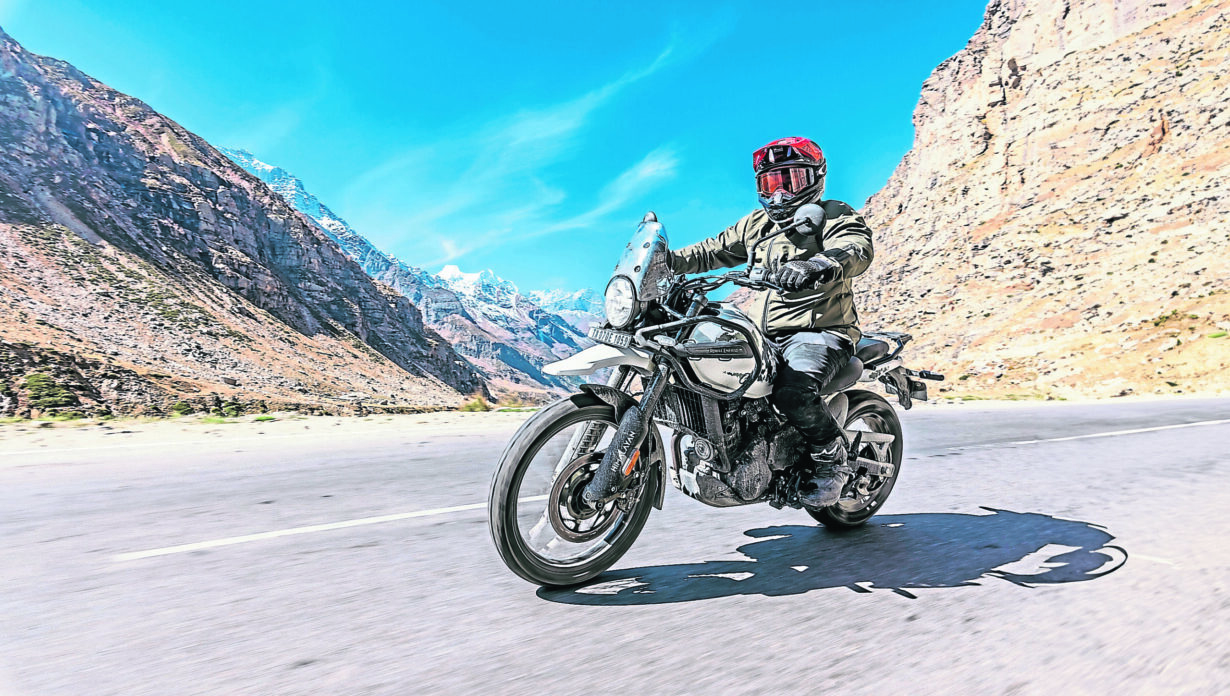The brilliant, bulletproof Adventure from India has had a serious overhaul for 2024 – and Adam ‘Chad’ Child has been to its birthplace to see what it’s made of…
The original Royal Enfield Himalayan quickly became a significant player in the adventure motorcycle market, thanks to its rugged simplicity and affordability (it was priced under £4000 when first launched). Now, the introduction of an all-new 450cc single-cylinder engine with water-cooling, ride-by-wire throttle, and double overhead camshafts – all firsts for the Indian manufacturer – represents a considerable advancement in terms of performance and technology. New features such as Showa suspension, riding modes, switchable ABS and a TFT dash with connectivity and navigation should also make the new Himalayan an even more capable and versatile machine.
We flew all the way to the Himalayas for 48 hours of crazy testing at 11,000 feet (and higher). Two days’ travelling, three planes and a scary taxi ride to get there: could the Himalayan live up to the name?

The introduction of a new 452cc single, the Sherpa 450, signifies a significant milestone for Enfield, as it introduces water-cooling, ride-by-wire technology and a dual overhead camshaft (DOHC) configuration – all firsts for the manufacturer. The Sherpa 450 unit is also an impressive 10kg lighter than the air-cooled engine it replaces.
In terms of performance, the 452cc single produces 40hp at 8000rpm and 40Nm/29.52lb-ft of torque at 5500rpm, and making a smoother, broader band of power. Some 90% of that peak torque is available from as low as 3000rpm, ensuring that the bike generates plenty of grunt wherever it is in the rev range.
The Himalayan’s new-found performance can’t really be described as spritely or thrilling, especially at altitude, but it does deliver a lovely slug of torque and fuss-free acceleration for a low-capacity single. At lower, more normal-to-Europeans altitudes, it will perform even better, making everyday overtaking and motorway cruising far more achievable. After all, keeping up with faster traffic on the outgoing Himalayan risked a dislocated wrist in a bid to squeeze out every last molecule of power.
The new Enfield Himalayan features a completely redesigned chassis and suspension set up but retains the old bike’s crucial and defining go-anywhere DNA. The 21-inch front wheel and 17-inch rear wheel combination are still present and correct, so, too, long-travel suspension and excellent ground clearance.
The non-adjustable 43mm Showa forks have 200mm of travel, which absorbs rough terrain effortlessly and provides a comfortable ride. At the rear there is a new single shock with spring preload adjustment and, like the front, 200mm of travel, which is 20mm more than the older model. This set up results in an impressive 230mm of ground clearance, which is 10mm more than the air-cooled Himalayan.
While inconsistent road conditions limited the ability to push the bike’s handling to the limit, initial impressions were positive. The CEAT Gripp tyres handled the heartstopping transformation from asphalt to moonscape without drama, although further testing with different road conditions may provide more insight into their performance.
Off-road, the Himalayan 450 excelled and, much like a trusty old Land Rover, navigated calmly around and over obstacles without fuss or once losing traction. Stable, reassuring and, in this wild and at times scary riding environment, immensely reassuring, it just kept plodding along.
The switchable ABS, which is either road or off-road (where there is no ABS on the rear wheel), allows for enhanced control in varied conditions. ABS can’t be switched off entirely. Traction control isn’t available and wasn’t missed due to the bike’s natural balance, perfectly metered low-end torque and excellent suspension, which enabled it to find traction and power – so long as it was dry and rocky (more off-road biased tyres would be required for any serious mud adventures). While some adjustments, like higher handlebars, could improve the bike’s standing position, the new Himalayan is as robust and reliable a companion for explorers and adventure riders as the older bike.
The new braking system features Indian-made Bybre calipers and represents another significant update. The front disc diameter has been increased to 320mm from 300mm, while the rear disc has also grown from 240mm to 270mm. The addition of ABS as standard, with the off-road setting, enhances the bike’s versatile safety features. These new brakes provide sufficient stopping power for the relatively heavy Himalayan. They’re not exactly razor-sharp but do deliver progressive and smooth braking performance, making them well suited for new riders and those exploring off-road terrain for the first time. In the Himalayas at least, the ABS system is not overly intrusive.
In the flesh, the new design of the Himalayan 450 makes the older 411 model appear dated. The neat headlight, integrated indicators and brake light, TFT dash and the unique crash bars around the fuel tank are cleverly designed and executed. The design department clearly has been working overtime; I like the new design, and a wide choice of colours and accessories allow for easy personalisation. Finally, a Himalayan you can be proud to own – and with prices starting at £5850, it’s not the bargain £4000 of the original, but it’s still priced very competitively. I reckon Enfield’s revamp of the Himalayan has clearly paid off.


